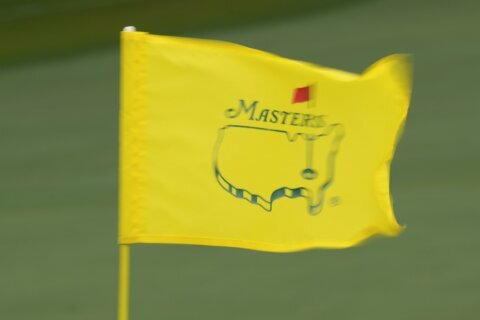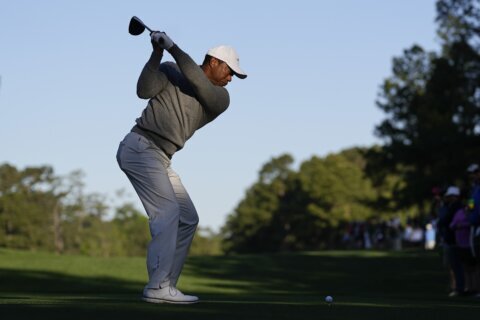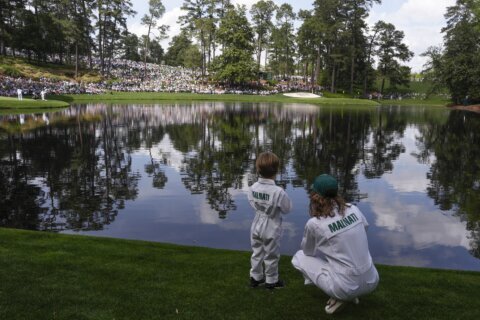KAPALUA, Hawaii (AP) — The scoreboard was filled with red numbers under par after the first round, all of them reaching double digits, the leading score at 59.
Soft and gentle Kapalua?
No, this was the PNC Championship. The low scores were the product of a two-player scramble.
But it raised a question that only sounded futuristic. How much longer before this is what it looks like after one round of stroke play on the PGA Tour?
Absurd?
No more than the world’s No. 1 player tying a PGA Tour record with 32 birdies, finishing at 33-under par and explaining how he finished second.
“A bittersweet moment,” Jon Rahm said.
By now, even the casual golf fan should recognize that when the turf is soft and the wind is on holiday, there is nothing to stop the best players in the world — and there is more of them than ever these days — from scores seemingly more suitable to a video game.
It was no less surreal to see the scores in the final hour of the Sentry Tournament of Champions. Only three players in PGA Tour history had ever finished a 72-hole tournament at 30-under par or lower. There were three players at 30 under or better at Kapalua, and they weren’t even done.
Kevin Kisner and Stewart Cink had just signed their cards Sunday when they looked up at a television outside the scoring room. Kisner had set a personal record at 24-under par. His previous best was 22 under in 2015 when he won at Sea Island by six shots. He tied for eighth at Kapalua, 10 shots behind.
Did they ever imagine seeing scoring like this?
“No wind, no defense,” Kisner said. “I just hope they don’t make the golf courses longer, because that doesn’t work.”
Cink looked at another aspect in the latest evolution of the royal and ancient game, and he found just the right words from the player standing next to him.
“To quote a famous golf philosopher,” he said, glancing Kisner’s way, “‘This ain’t no hobby.’”
Yes, the equipment is better, both the clubs and golf balls in the players’ hands and the machines that keep golf courses as immaculate as the weather allows. The technology improves every year, from launch monitors to instant video instruction off mobile phones.
Not to be overlooked is the money, which is attracting better athletes. And that’s what is behind the increasingly low scoring as much as anything.
This was bound to happen, and so much of it traces back to Tiger Woods.
“You have what’s probably a lot of purists of the game who are probably going, ‘Oh, you’ve got to roll the ball back, shorter drivers, do this, do that,’” Rahm said after finishing one shot behind Cameron Smith at Kapalua.
“The simple fact is since Tiger started playing golf, you’re getting people that take this game a lot more seriously,” he said. “Everybody thinks about it more like athletes. So the level of the game is a lot higher than it used to be.”
Players are careful with their words when discussing how hard it is to win in today’s game so that nothing is taken away from what Woods achieved at his peak, some of which most likely won’t ever be repeated (142 consecutive cuts, holding all four major titles at the same time, 52 consecutive rounds at par or better on the PGA Tour).
But the competition is stronger. Whether he still would have won 82 times is not the point. Woods had David Duval, Phil Mickelson, Ernie Els and Vijay Singh challenging him. Now, there is no one as good as Woods, but a dozen just like the ones who once challenged him, and the roster keeps getting deeper.
“He was better than all of us have ever been,” Rahm said. “But overall, I think the average player, it’s a better golf player.”
Cink arrived on the PGA Tour at roughly the same time as Woods, and he has seen how the game has changed. It’s not just a game to play. It’s a sport that consumes the best.
“Your ability got you a lot more than it does now,” Cink said. “Now your ability gets you a crack in the door. It’s another story when you get out here. The level of play continues to increase. The trajectory is increasing steeply.”
Rory McIlroy once said golf is such a nostalgic game that first memories will always be the fondest, whether that was Ben Hogan with a 1-iron at Merion or Seve Ballesteros with any club from any lie or Woods winning majors by double-digit margins.
David Hunter is a peculiar piece of golf history. He was the first player to break 70 in a major (68) in the 1909 U.S. Open. Branden Grace now holds the record at 62 in the 2017 British Open. That will fall, maybe this summer, particularly if St. Andrews is without its best defense — wind.
Arnold Palmer famously said in 1960, “Doesn’t 280 always win the U.S. Open?” right before he charged his way from seven shots behind with a 65 to win the Open at Cherry Hills.
He finished at 280, a score that would not have won seven of the last 10 times in the U.S. Open.
The game evolves, and always has. As long as the low score still wins, golf will be fine. It just might not be the sport exactly as you remember it. Not many sports are.
___
For more AP golf coverage: https://apnews.com/hub/golf and https://twitter.com/AP_Sports
Copyright © 2024 The Associated Press. All rights reserved. This material may not be published, broadcast, written or redistributed.







